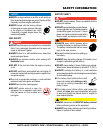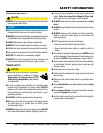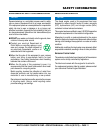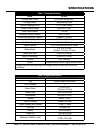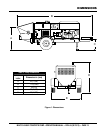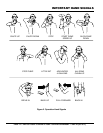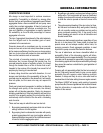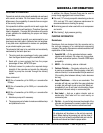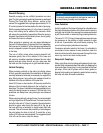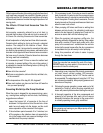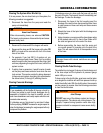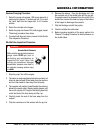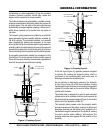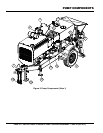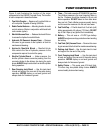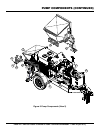
GENERAL INFORMATION
Downhill Pumping
Downhill pumping can be a difficult procedure on some
jobs. The slurry procedure would be the same as explained
Priming The Pump With Slurry Mixture section of this
manual. It is suggested that a sponge approximately 2”x 4”x
6” in size be placed in the hose before the start of pumping.
Wet the sponge before placing it in the hose to keep the
slurry from running too far ahead of the concrete, which
will reduce the possibility of separation. When the pump is
stopped, the material can flow slowly down, due to gravity,
and cause the hose to collapse.
When pumping is resumed, you can expect blockage at
the point of hose collapse. To prevent this from happening,
the hose can be “kinked off” at the discharge end when the
pump is stopped to prevent the gravity flow of the material
in the hose.
The use of stiffer mixes when pumping downhill will
decrease gravity flow of the material in the hose and
will assure a smoother operation between the cam roller
bearing and cam plate. As with any job, make sure that
the hose and the couplings are in good workable shape.
When pumping vertically up the side of a building, above
40 feet, we would recommend the installation of steel pipe
securely fastened at intervals as necessary to support the
pipe. Ninety degree, long radius pipe sweeps should be
installed at the top and bottom of the steel line.
Use a 25 ft. hose, or short section, off the pump; and for the
balance of the horizontal distance to the vertical line, use
steel pipe. This type of installation has been satisfactory on
many jobs being pumped in excess of 100 feet high. Line
pressures are always less using steel pipe as compared
to hose.
When pumping vertically, using all hose, it is recommended
not to go higher than 50 feet with hose. The hose should be
tied off at intervals of 10 feet, if possible. Special attention
should be given when tieing the hose off at the top as
the hose will have a tendency to stretch when filled with
concrete. This will increase the possibility of a blockage at
the point where the hose is tied off. To avoid this, a long
radius of 90° elbow is recommended. The suggested place
to tie off is on the hose, under the clamp.
Hose Pulsation
A slight pulsation of the hose will always be noticeable near
the pump. Excessive pulsation of the hose near the pump is
normally due to higher than average line pressures caused
by stiff, harsh mixes, or extremely long pumping distances.
The use of 2 -1/2” I.D. hose in these extreme cases reduces
line pressures or the addition of slight amounts of water
to the mix, if permissible, will permit easier pumping. The
use of certain pumping admixtures may help.
If excessive pulsation exists in the hose, it is advisable to
use burlap or some means of wear protection under the
hose at points where the hose may wear through the outer
cover; e.g. over forms, steel or sharp curbs.
Snap-Joint Couplings
When using Snap-Joint couplings with gaskets to join hose,
see that they are washed clean after each job. Keeping the
hose ends clean (heavy duty) is very important for the best
job setup. A thin coat of grease on the rubber gasket or
dipping both coupling and gasket in water before coupling
the hose will make for easier installation.
NOTICE
It is strongly recommended that steel pipe be used on all
vertical pumping for safety and convenience.



